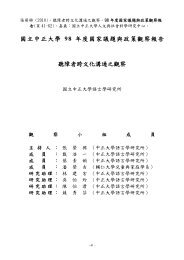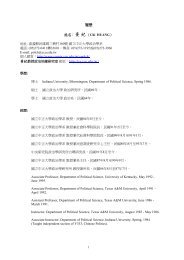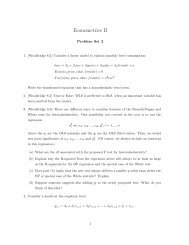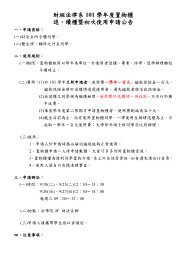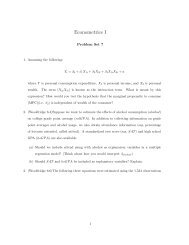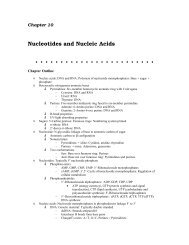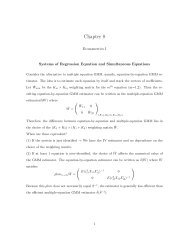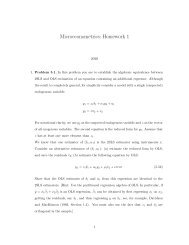Chapter 10: Basic Linear Unobserved Effects Panel Data Models:
Chapter 10: Basic Linear Unobserved Effects Panel Data Models:
Chapter 10: Basic Linear Unobserved Effects Panel Data Models:
Create successful ePaper yourself
Turn your PDF publications into a flip-book with our unique Google optimized e-Paper software.
<strong>Chapter</strong> <strong>10</strong>: <strong>Basic</strong> <strong>Linear</strong> <strong>Unobserved</strong> <strong>Effects</strong> <strong>Panel</strong> <strong>Data</strong><strong>Models</strong>:Microeconomic Econometrics ISpring 20<strong>10</strong><strong>10</strong>.1 Motivation: The Omitted Variables ProblemWe are interested in the partial effects of the observable explanatory variables x j in the populationregression functionE(y|x 1 , x 2 ,..., x k , c) (<strong>10</strong>.1)• An unobserved,time-constant variable is called an unobserved effect in panel data analysis.• Such a data set is usually called a balanced panel because the same time periods areavailable for all cross section units.1
• Example<strong>10</strong>.1(Program Evaluation):log(wage it ) = θ t + z it γ + δ 1 prog it + c i + u it (<strong>10</strong>.16)• Example <strong>10</strong>.2 (Distributed Lag Model):patents it = θ t + z it γ + δ 0 RD it + δ 1 RD i,t−1 + ··· + δ 5 RD i,t−5 + c i + u it (<strong>10</strong>.17)4
• Example <strong>10</strong>.3 (Lagged Dependent Variable):log(wage it ) = β 1 log(wage i,t−1 ) + c i + u it , t = 1,2,..., T (<strong>10</strong>.18)<strong>10</strong>.3 Estimating <strong>Unobserved</strong> <strong>Effects</strong> <strong>Models</strong> by Pooled OLSUnder certain assumptions, the pooled OLS estimator can be used to obtain a consistent estimatorof β in model (<strong>10</strong>.11). Write the model asy it = x it β + υ it , t = 1,2,..., T (<strong>10</strong>.21)where υ it ≡ c i + u it , t = 1,2,...T are the composite errors.5
<strong>10</strong>.4 Random <strong>Effects</strong> Methods<strong>10</strong>.4.1 Estimation and Inference under the <strong>Basic</strong> Random <strong>Effects</strong>Assumptions• As with pooled OLS, a random effects analysis puts c i into the error term.• Assumption RE.1:1. E(u it |x i , c i ) = 0, t = 1,..., T.2. E(c i |x i ) = E(c i ) = 0where x i ≡ (x i1 , x i2 ,..., x iT ).• Assumption RE.2: rank E(X ′ i Ω−1 X i ) = K.• When Ω has the form (<strong>10</strong>.31), we say it has the random effects structure.• Assumption RE.3:1. E(u i u ′ i |x i, c i ) = σ 2 u I T.2. E(c 2 i |x i) = σ 2 c• In a panel data context, the FGLS estimator that uses the variance matrix (<strong>10</strong>.33) is whatis known as the random effects estimator:( N∑ˆβ RE = X ′ ˆΩ) −1 ( N∑−1iX i X ′ ˆΩ)−1iy ii=1i=1(<strong>10</strong>.34)• Example <strong>10</strong>.4(RE Estimation of the <strong>Effects</strong> of Job Training Grants):log(ŝcrap) = .415 − .093 d88 − .270 d89 + .548 union − .215 grant − .377 grant −1(.243) (.<strong>10</strong>9) (.132) (.411) (.148) (.205)6
<strong>10</strong>.4.2 Robust Variance Matrix Estimator<strong>10</strong>.4.3 A General FGLS AnalysisIf the idiosyncratic errors u it : t = 1,2,..., T are generally heteroskedastic and serially correlatedacross t, a more general estimator of Ω can be used in FGLS:ˆΩ = N −1 ∑ N ˆv i ˆv ′ i(<strong>10</strong>.38)i=17
<strong>10</strong>.4.4 Testing for the Presence of an <strong>Unobserved</strong> EffectFrom equation (<strong>10</strong>.37), we base a test of H 0 : σ 2 c = 0 on the null asymptotic distribution ofN −1/2 N ∑T−1 ∑T∑i=1 t=1 s=t+1ˆυ it ˆυ is (<strong>10</strong>.39)which is essentially the estimator ˆσ 2 c scaled up by N.<strong>10</strong>.5 Fixed <strong>Effects</strong> Methods<strong>10</strong>.5.1 Consistency of the Fixed <strong>Effects</strong> EstimatorAgain consider the linear unobserved effects model for T time periods:y it = x it β + c i + u it , t = 1,..., T (<strong>10</strong>.41)8
• Assumption FE.1: E(u it |x i , c i ) = 0, t = 1,2,..., T.• In this section we study the fixed effects transformation, also called the within transformation.• The fixed effects (FE) estimator, denoted by ˆβFE ,is the pooled OLS estimator from theregressionÿ it on ẍ it , t = 1,2,..., T; i = 1,2,..., N (<strong>10</strong>.48)• This set of equations can be obtained by premultiplying equation (<strong>10</strong>.42) by a timedemeaningmatrix.• Assumption FE.2: rank( ∑Tt=1E(ẍ ′ itẍit))[ ]= rank E(Ẍ ′ i Ẍ i) = K.• It is also called the within estimator because it uses the time variation within each crosssection.• The between estimator, which uses only variation between the cross section observations,is the OLS estimator applied to the time-averaged equation (<strong>10</strong>.45).9
<strong>10</strong>.5.2 Asymptotic Inference with Fixed <strong>Effects</strong>• Assumption FE.3: E(u i u ′ i |x i, c i ) = σ 2 u I T.• To see how to estimate σ 2 u , we use equation (<strong>10</strong>.51) summed across t : ∑ Tt=1E(ü 2 it ) = (T −1)σ 2 u , and so [N(T − ∑ 1)]−1 N∑ Tt=1i=1E(ü 2 it ) = σ2 u .Now, define the fixed effects residuals asû it = ÿ it − ẍ it ˆβFE , t = 1,2,..., T; i = 1,2,..., N (<strong>10</strong>.55)which are simply the OLS residuals from the pooled regression (<strong>10</strong>.48).• Example <strong>10</strong>.5(FE Estimation of the <strong>Effects</strong> of Job Training Grants):log(ŝcrap) = −.080 d88 − .247 d89 − .252 grant − .422 grant −1(.<strong>10</strong>9) (.133) (.151) (.2<strong>10</strong>)<strong>10</strong>
<strong>10</strong>.5.3 The Dummy Variable Regression• The estimator of β obtained from regression (<strong>10</strong>.57) is, in fact, the fixed effects estimator.This is why ˆβFE is sometimes referred to as the dummy variable estimator.<strong>10</strong>.5.4 Serial Correlation and the Robust Variance Matrix EstimatorApplying equation (7.26), the robust variance matrix estimator of ˆβFE isAva ˆr( ˆβFE ) = (Ẍ ′ Ẍ) −1( ∑ N Ẍ iûiû ′ ′ i Ẍ i)(Ẍ ′ Ẍ) −1 (<strong>10</strong>.59)which was suggested by Arellano (1987) and follows from the general results of White (1984,<strong>Chapter</strong> 6).i=111
• Example <strong>10</strong>.5 (continued):log(ŝcrap) = −.080 d88 − .247 d89 − .252 grant − .422 grant −1(.<strong>10</strong>9) (.133) (.151) (.2<strong>10</strong>)[.096] [.193] [.140] [.276]<strong>10</strong>.5.5 Fixed <strong>Effects</strong> GLS• Assumption FEGLS.3: E(u i u ′ i |x i, c i ) = Λ, a T × T positive definite matrix.• The fixed effects GLS (FEGLS) estimator is defined byˆβ FEGLS = ( ∑ N Ẍ ′ ˆΩ −1 ) −1 ( ∑ NiẌ i Ẍ ′ ˆΩ −1 )i ÿ ii=1i=1where Ẍ i and ÿ i are defined with the last time period dropped.12
• Assumption FEGLS.2: rankE(Ẍ ′ i ˆΩ −1 Ẍ i ) = K.<strong>10</strong>.5.6 Using Fixed <strong>Effects</strong> Estimation for Policy AnalysisConsider the modely it = x it β + υ it = z it γ + δw it + υ itwhere υ it may or may not contain an unobserved effect.13
<strong>10</strong>.6 First Differencing Methods<strong>10</strong>.6.1 Inference• Assumption FD.1: Same as Assumption FE.1.Lagging the model (<strong>10</strong>.41) one period and subtracting gives∆y it = ∆x it β + ∆u it , t = 2,3,..., T (<strong>10</strong>.63)where ∆y it = y it − y i,t−1 , ∆x it = x it − x i,t−1 , and ∆u it = u it − u i,t−1 .• As with the FE transformation, this first-differencing transformation eliminates the unobservedeffect c i .• The first-difference (FD) estimator, ˆβF D, is the pooled OLS estimator from the regression∆y it on ∆x it , t = 2,..., T; i = 1,2,..., N (<strong>10</strong>.65)∑Tt=2)• Assumption FD.2: rank(E(∆x ′ it ∆x it) = K.• Assumption FD.3: E(e i e ′ i |x i1,..., x iT , c i ) = σ 2 e I T−1, where e i is the (T − 1) × 1 vector containinge it ,t = 2,..., T.14
<strong>10</strong>.6.2 Robust Variance MatrixIf Assumption FD.3 is violated, then, as usual, we can compute a robust variance matrix. Theestimator in equation (7.26) applied in this context isAvar( ˆ ˆβFD ) = (∆X ′ ∆X) −1( ∑ N )∆X ′ i êi ê ′ i ∆X i (∆X ′ ∆X) −1 (<strong>10</strong>.70)where ∆X denotes the N(T − 1) × K matrix of stacked first differences of x it .i=1• Example <strong>10</strong>.6 (FD Estimation of the <strong>Effects</strong> of Job Training Grants):∆log(scrap it ) = δ 1 + δ 2 d89 t + β 1 ∆grant it + β 2 ∆grant i,t−1 + ∆u it15
<strong>10</strong>.6.3 Testing for Serial CorrelationThe regression is based on T − 2 time periods:ê it = ˆp 1 ê i,t−1 + error it , t = 3,4,..., T; i = 1,2,..., N (<strong>10</strong>.71)• Example<strong>10</strong>.6 (continued):<strong>10</strong>.6.4 Policy Analysis Using First DifferencingIn this one case,∆prog i = ∆prog i2 ,and the first-differenced equation can be written as∆y i2 = θ 2 + ∆z i2 γ + δ 1 prog i2 + ∆u i2 (<strong>10</strong>.72)16
• When ∆z i2 is omitted, the estimate of δ 1 from equation (<strong>10</strong>.72) is the difference-indifferences(DID) estimator (see Problem <strong>10</strong>.4): ˆ∆ 1 = ∆y t reat − ∆y c ortrol.<strong>10</strong>.7 Comparison of Estimators<strong>10</strong>.7.1 Fixed <strong>Effects</strong> versus First DifferencingWith more than two time periods, a test of strict exogeneity is a test of H 0 : γ = 0 in the expandedequation∆y t = ∆x t β + w t γ + ∆u t , t = 2,..., Twhere w t is a subset of x t (that would exclude time dummies).17
<strong>10</strong>.7.2 The Relationship between the Random <strong>Effects</strong> and Fixed <strong>Effects</strong>EstimatorsUsing the fact that j ′ T j T = T, we can write Ω under the random effects structure asΩ = σ 2 u I T + σ 2 c j T j ′ T = σ2 u I T + Tσ 2 c j T( j ′ T j T) −1 j ′ T = σ2 u I T + Tσ 2 c P T = (σ 2 u + σ2 c )(P T + ηQ T )where P T ≡ I T −Q T = j T ( j ′ T j T) −1 j ′ T and η ≡ σ2 u /(σ2 u + Tσ2 c ).• Equation (<strong>10</strong>.76) shows that the random effects estimator is obtained by a quasitimedemeaning: rather than removing the time average from the explanatory and dependentvariables at each t, random effects removes a fraction of the time average.• Example <strong>10</strong>.7 (Job Training Grants):<strong>10</strong>.7.3 The Hausman Test Comparing the RE and FE Estimators18



